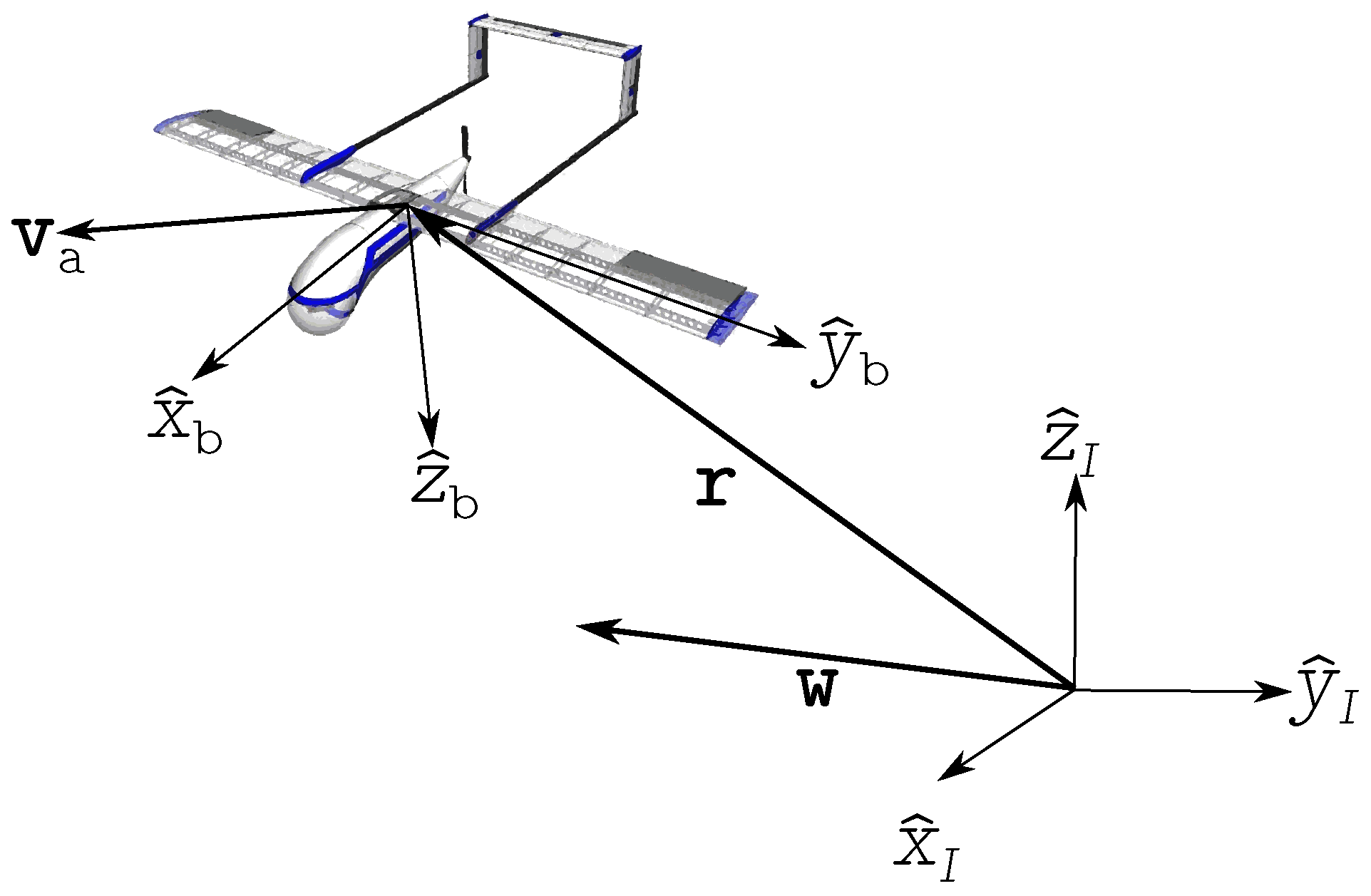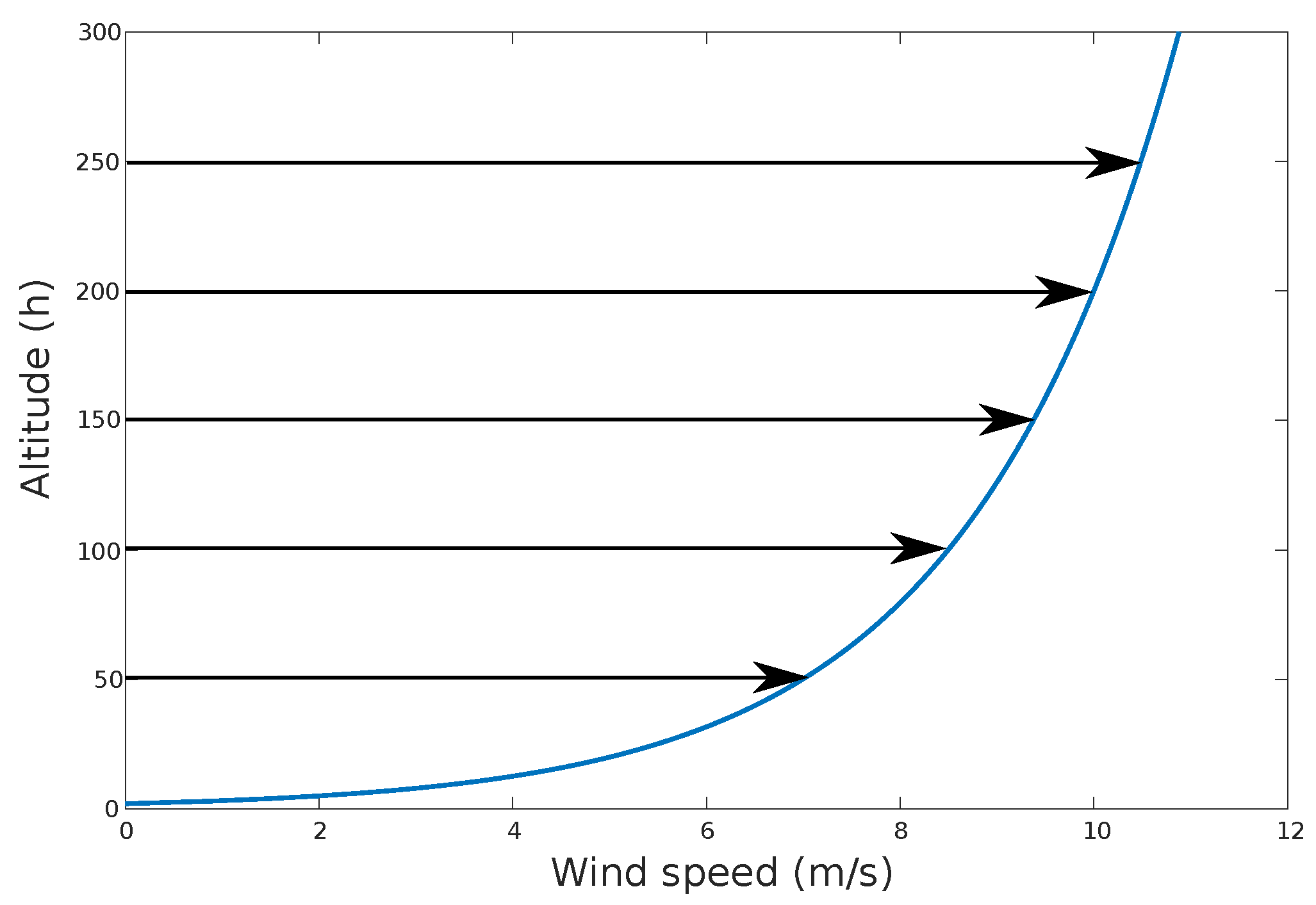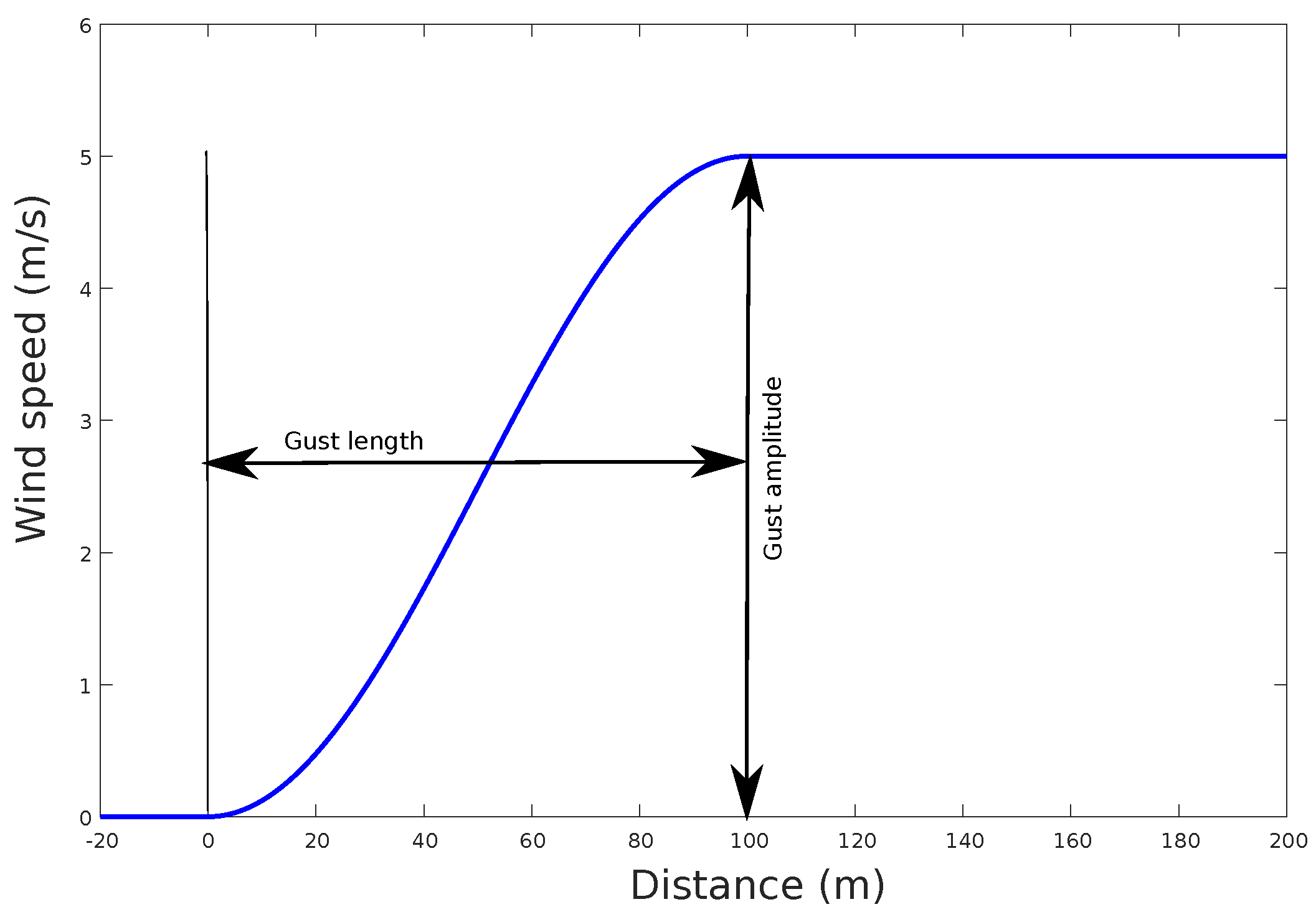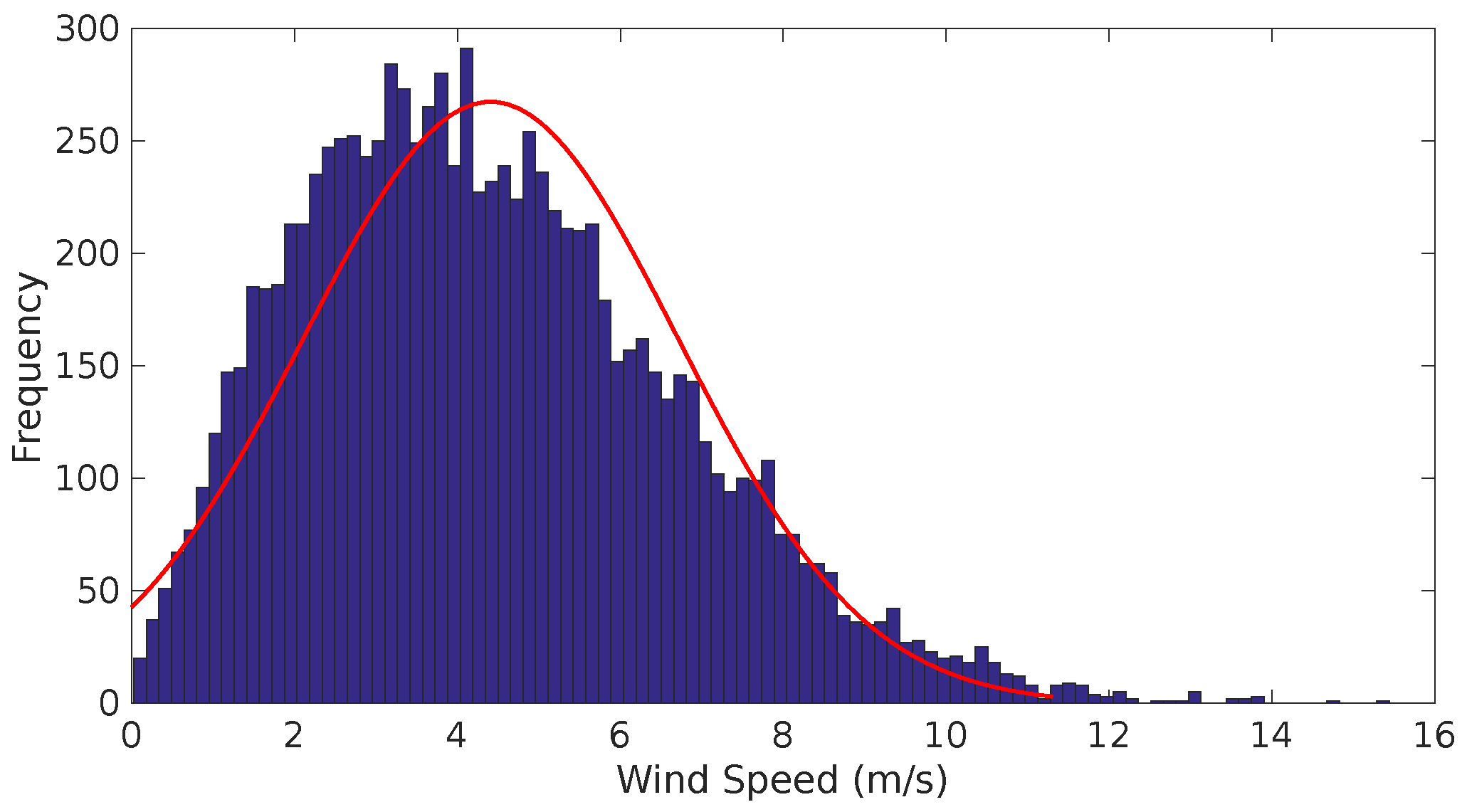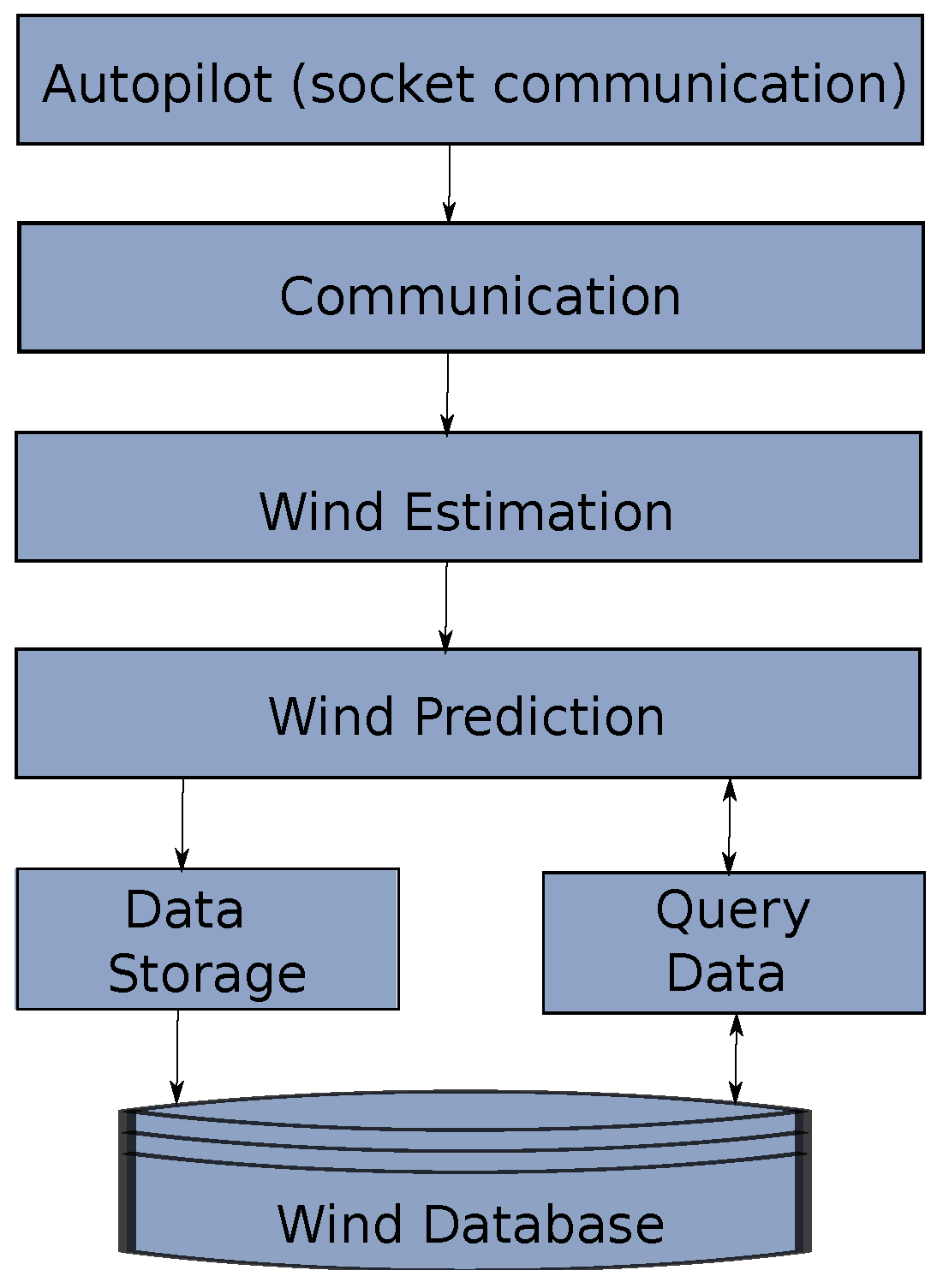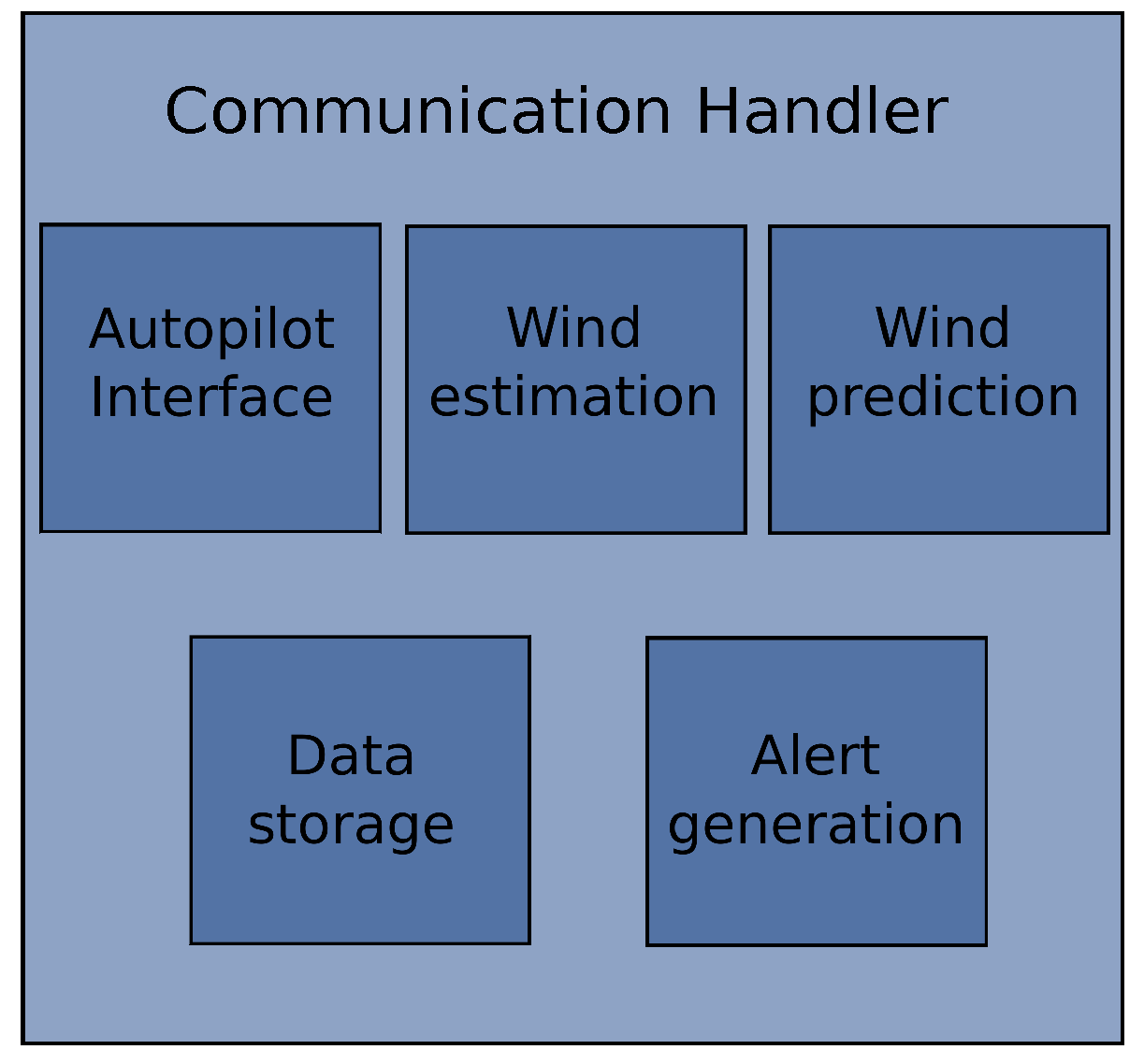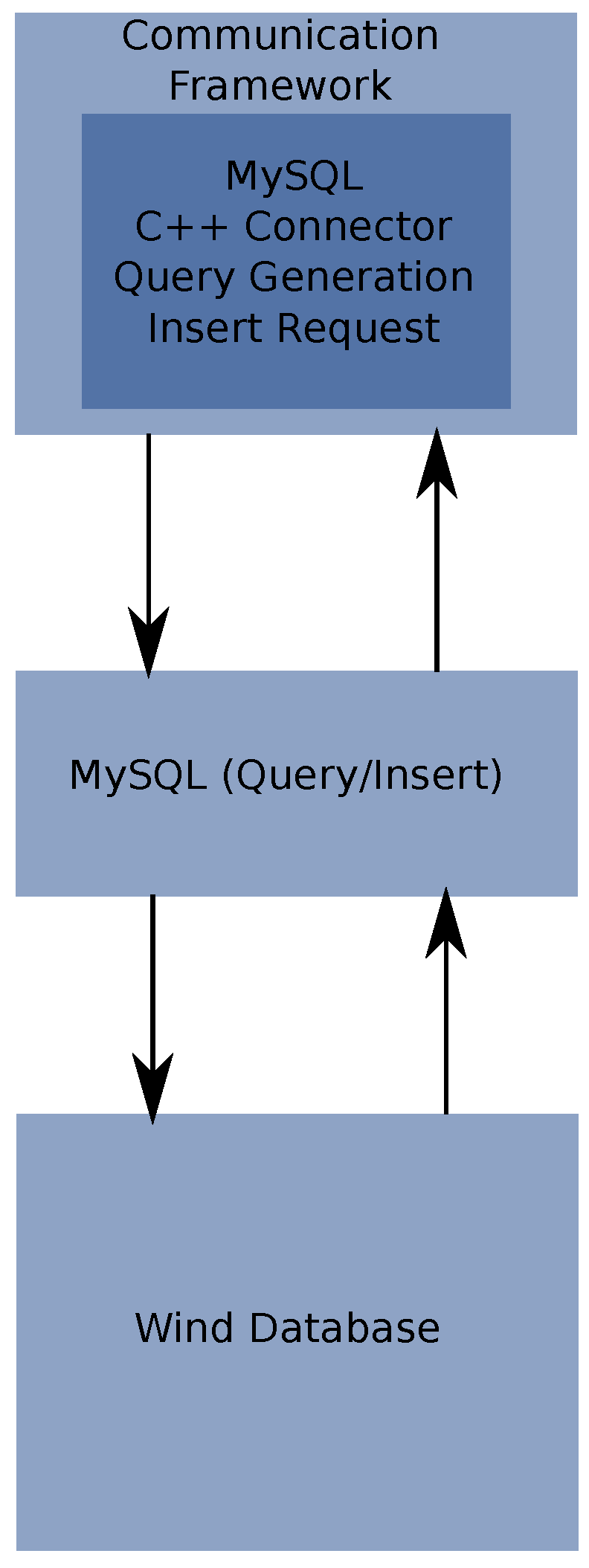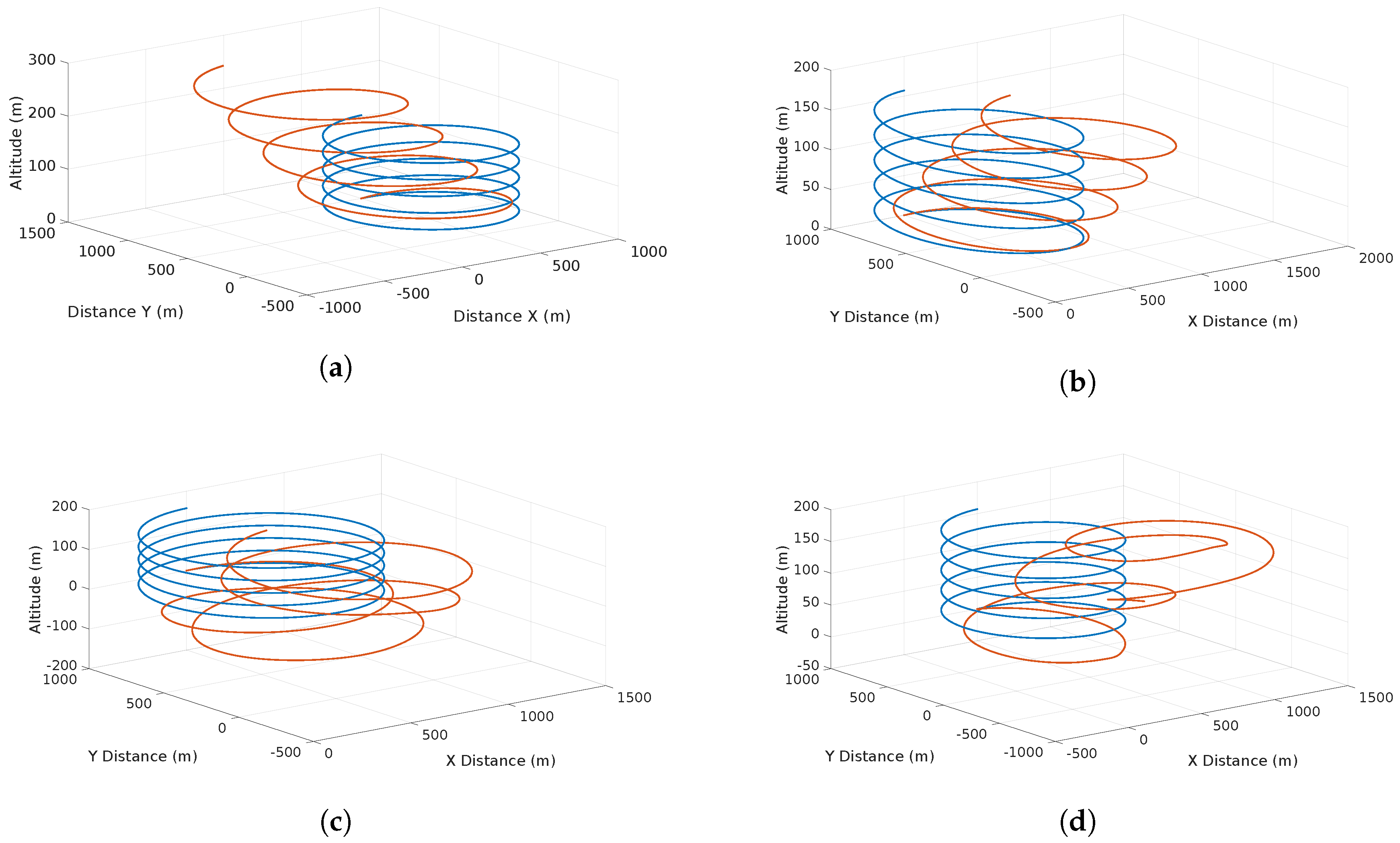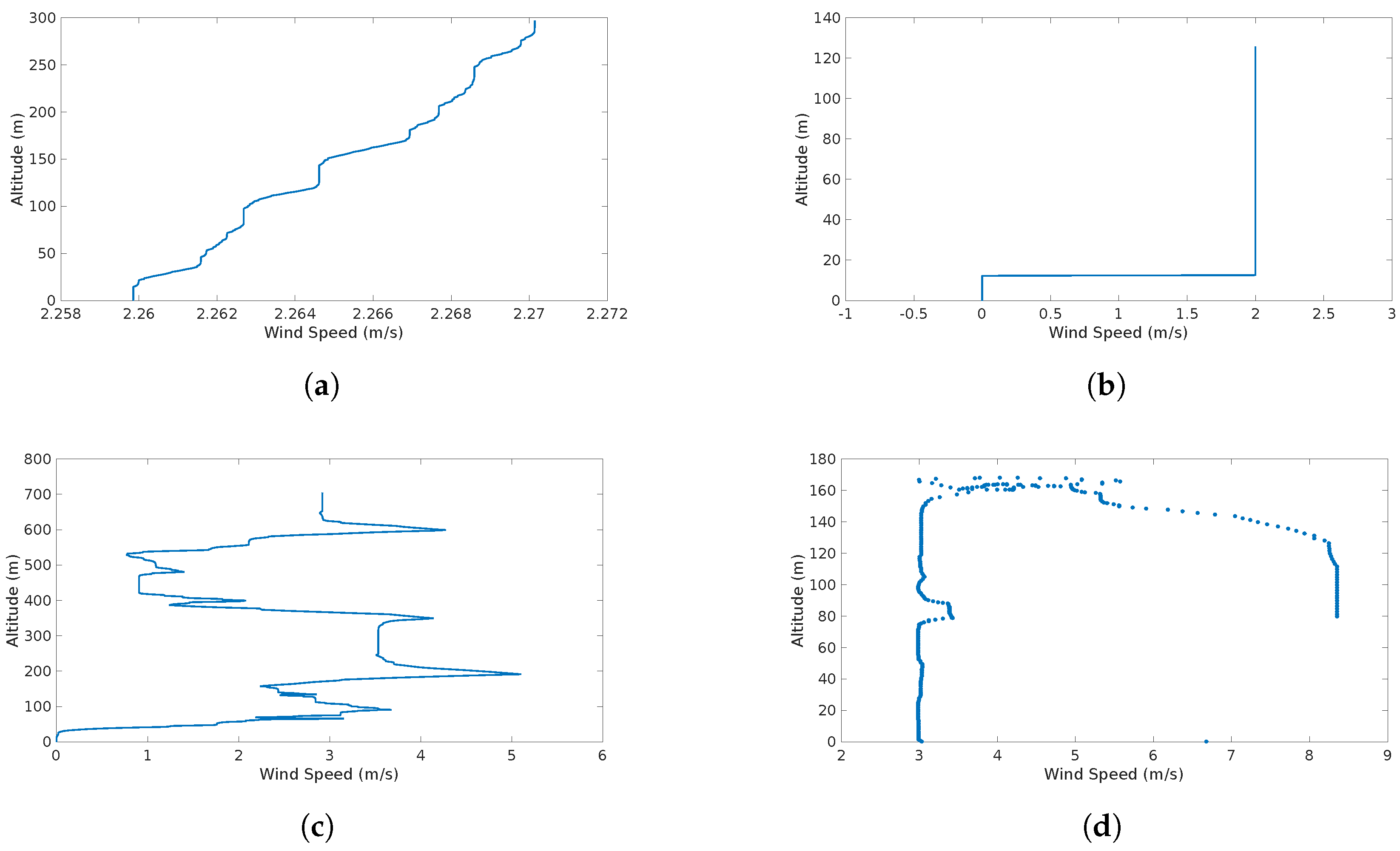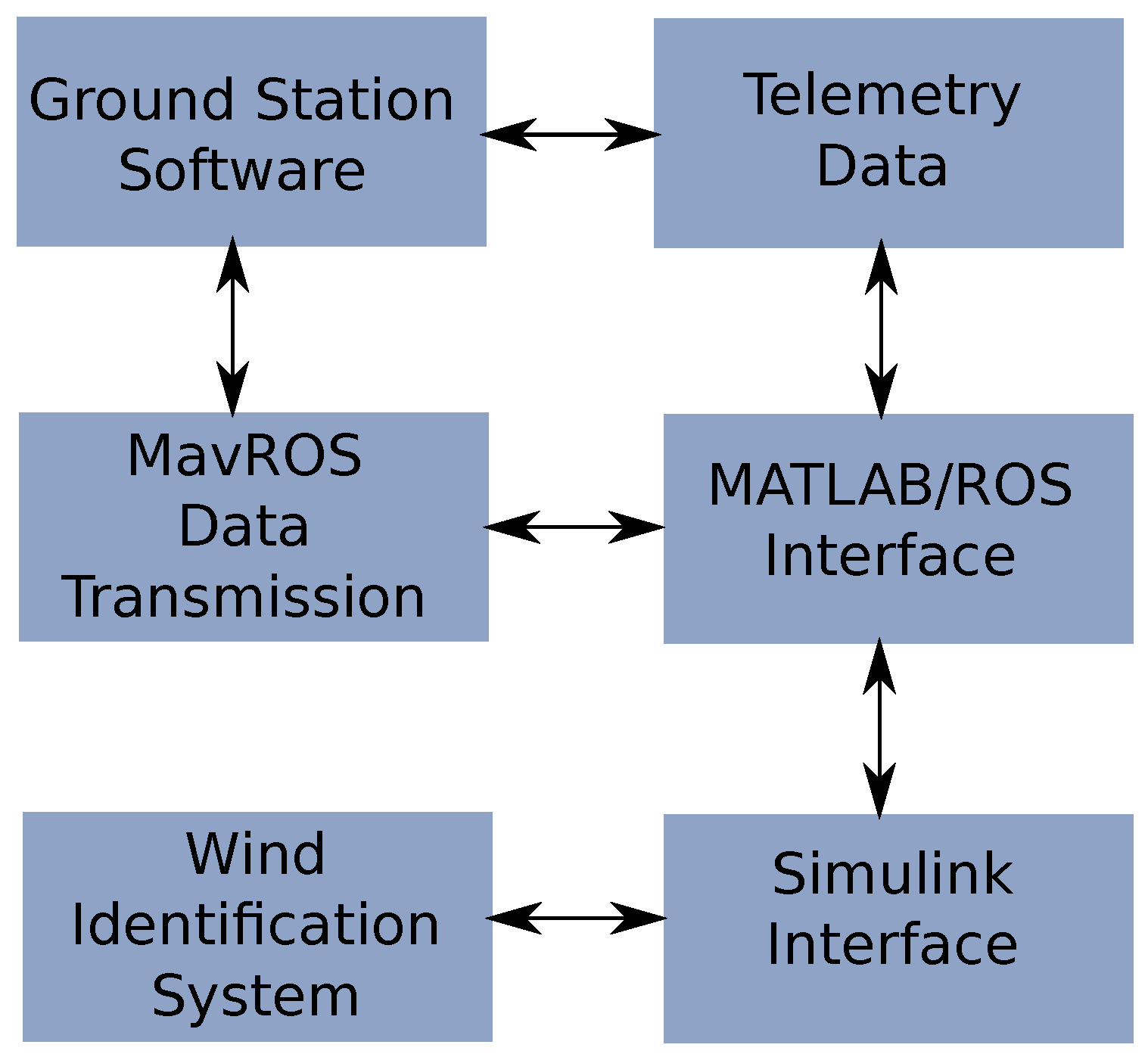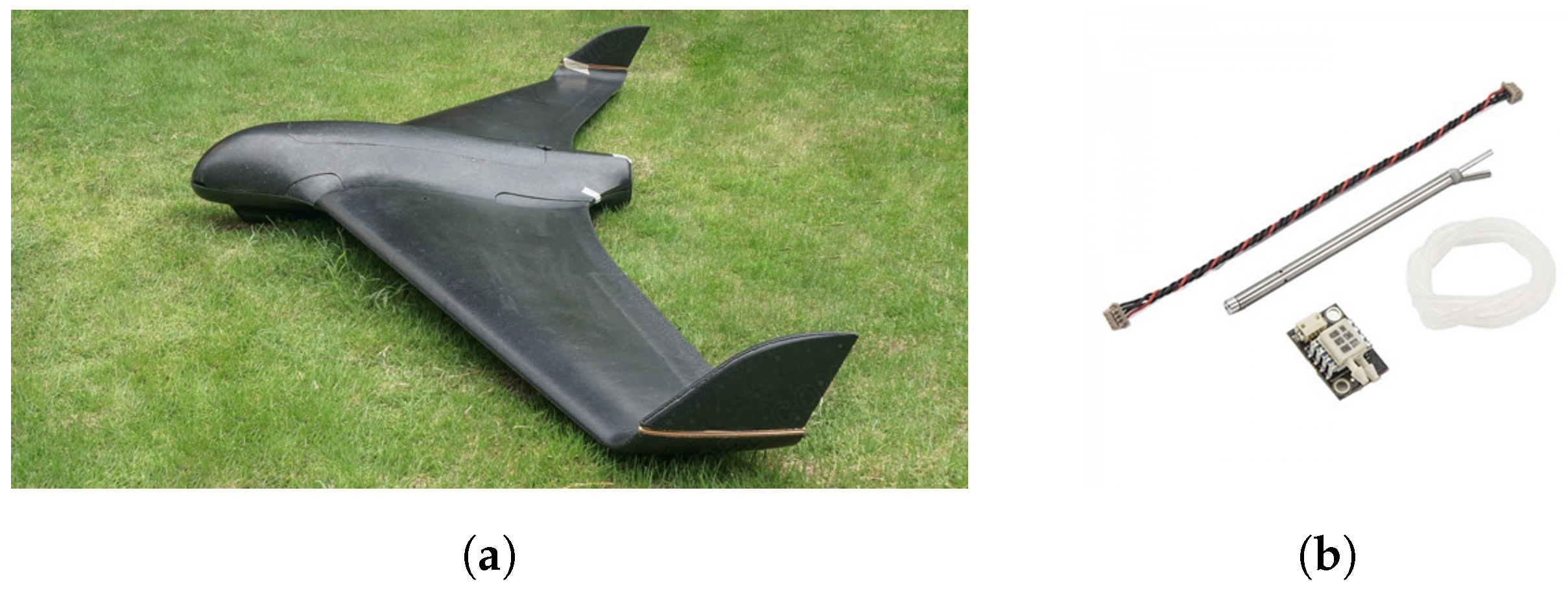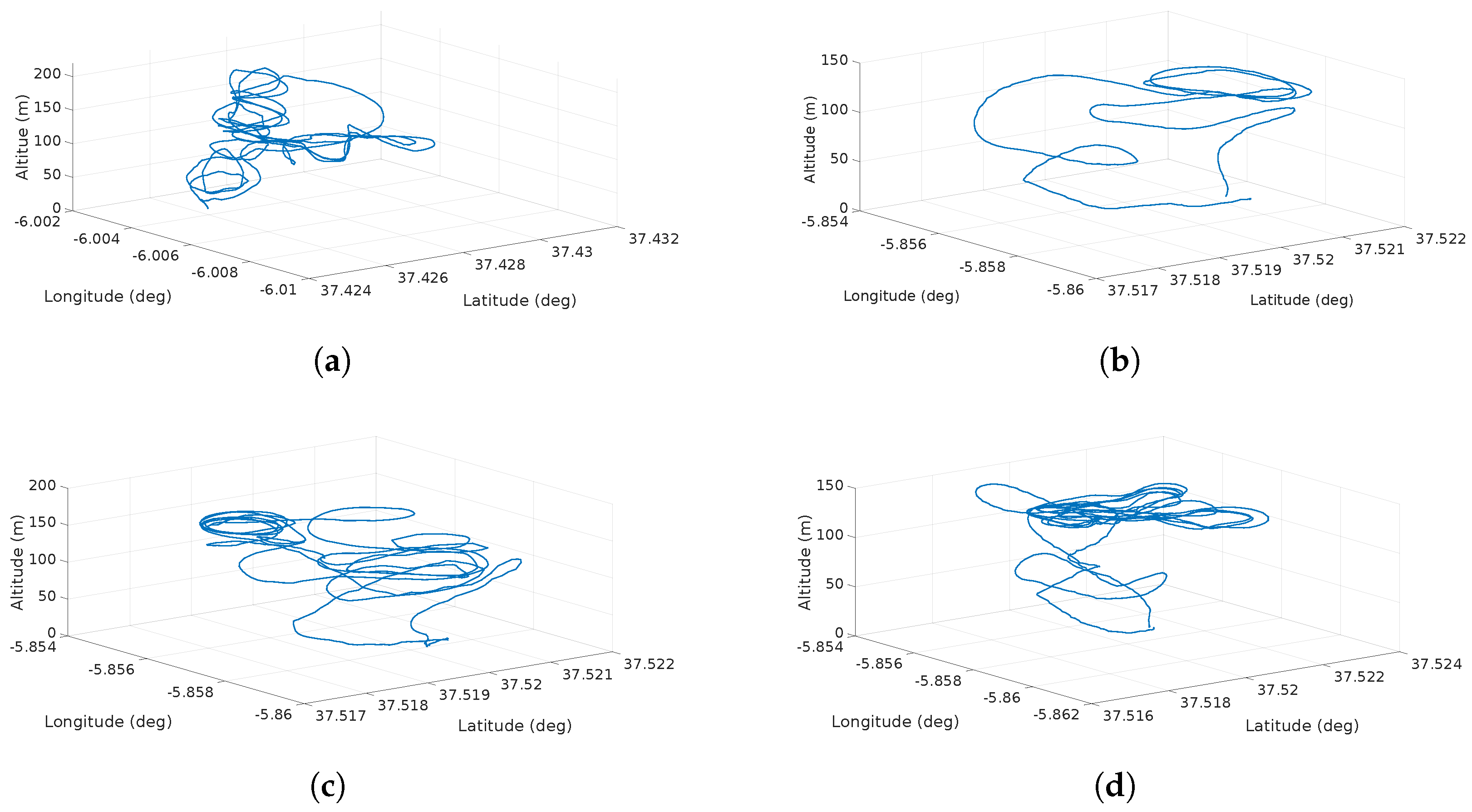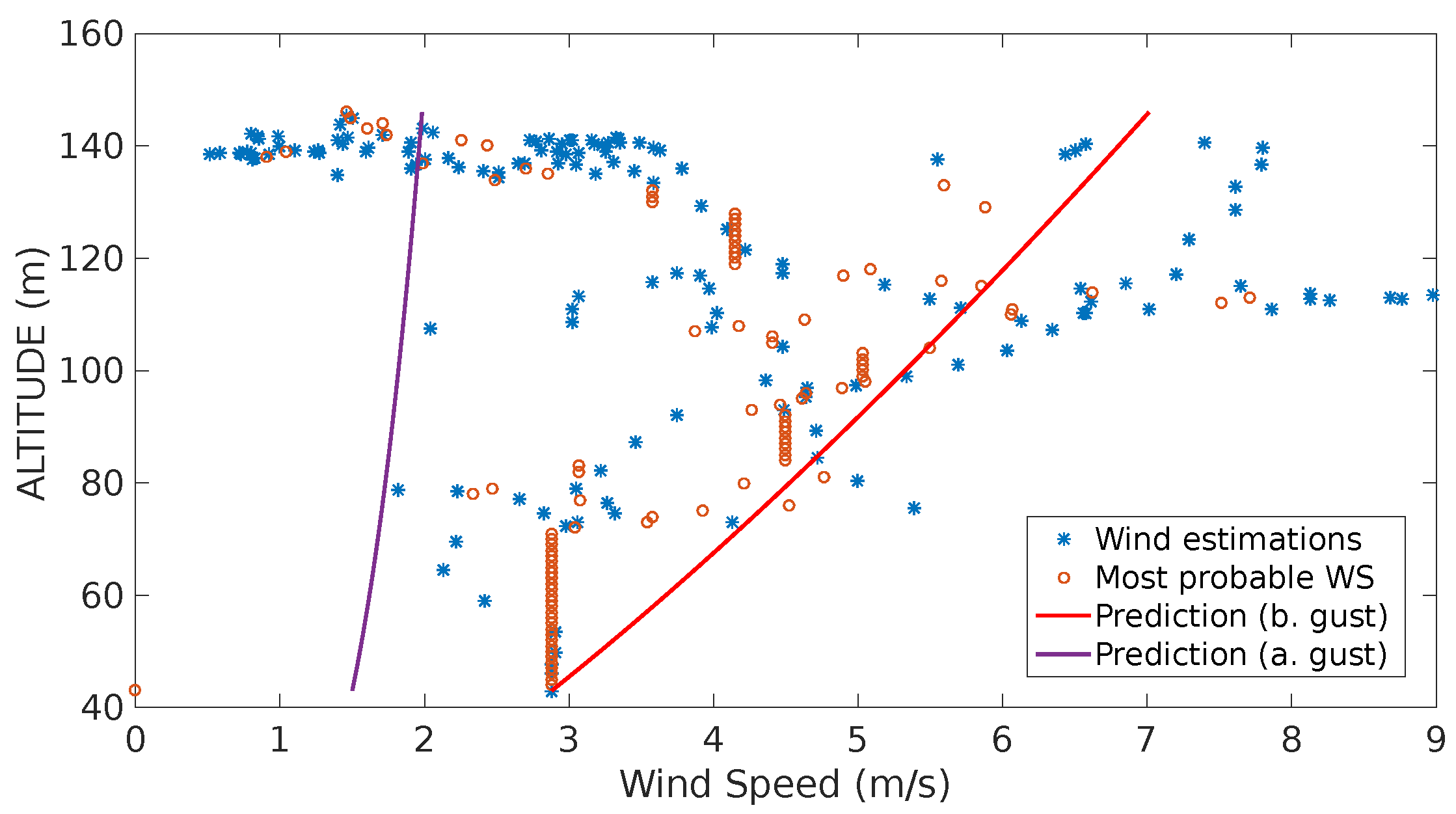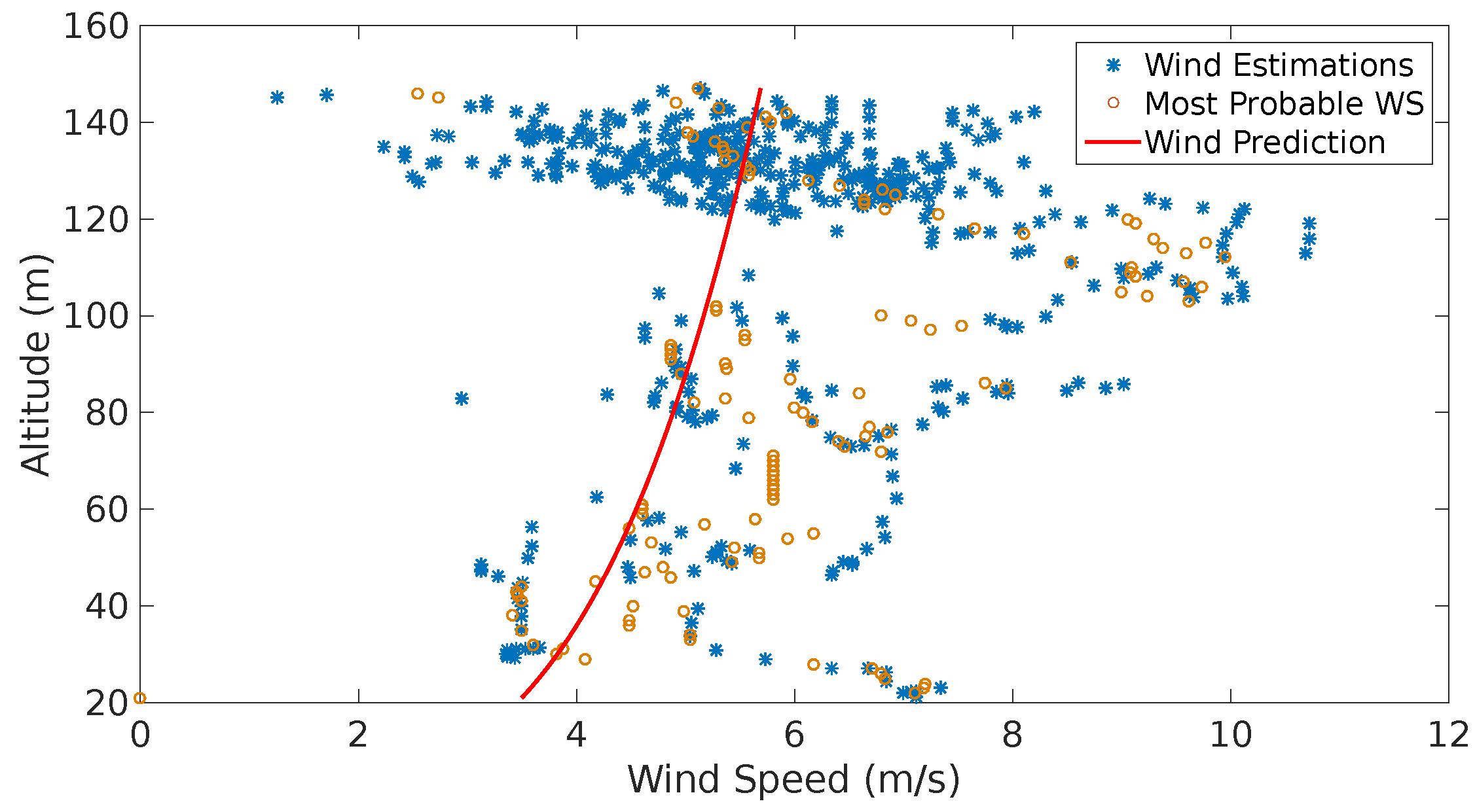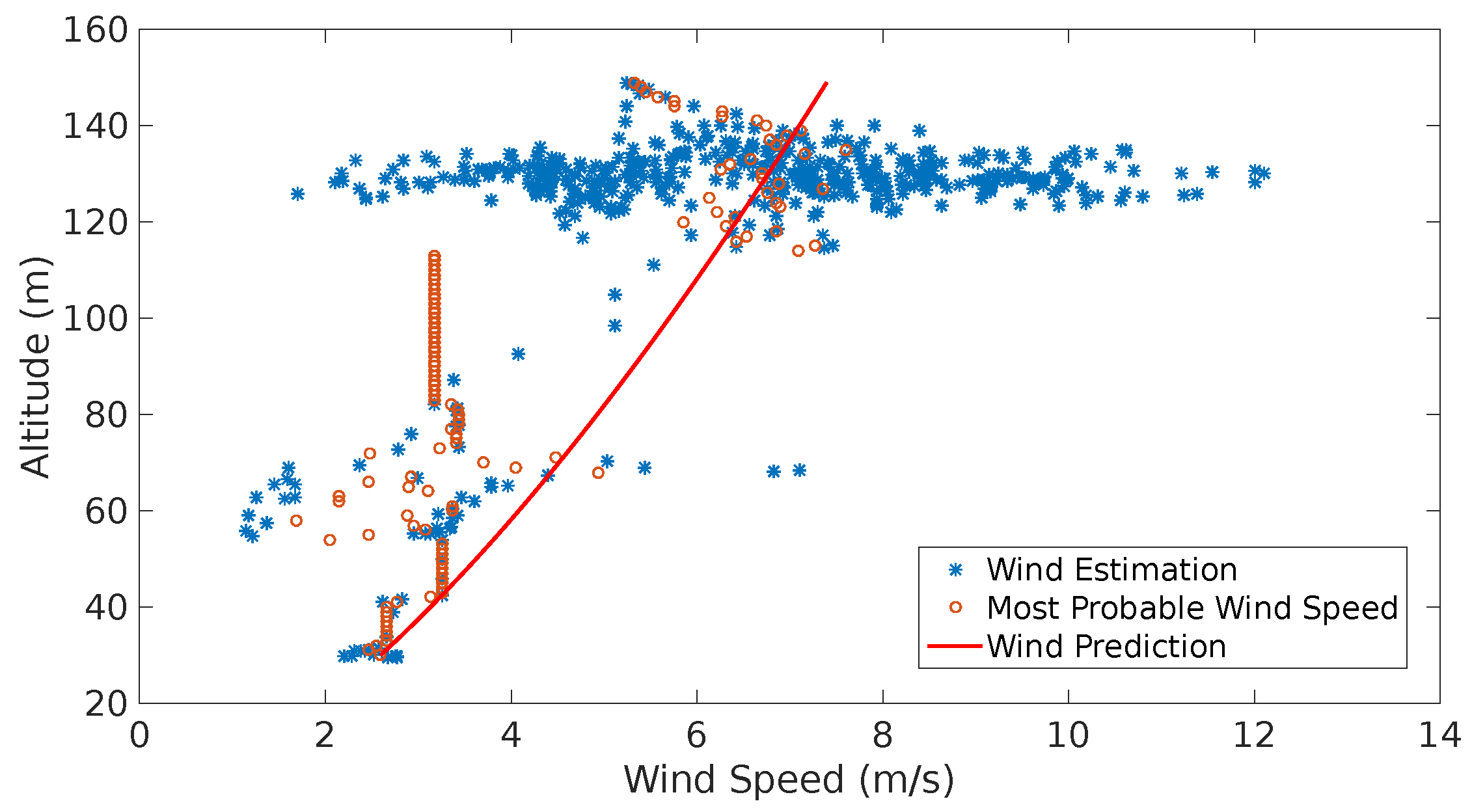1. Introduction
Current UAS technology has advanced in such a way that any unexperienced user is able to plan a route with relatively good accuracy. As the reliability has increased, applications using small UAS are growing rapidly. In addition, nonlinear natural effects, such as winds, can be compensated even with Commercial-Off-The-Shelf (COTS) components. Nevertheless, to compensate wind effects efficiently, the use of a sensor that can provide wind measurements is sometimes limited by the platform payload and the cost. This leads to inefficient attitude compensations, producing drift and sometimes missing waypoints, which may result likely into higher energy consumptions [
1]. Currently, there are several research efforts to provide wind estimations without a direct measurement of the wind. Langelaan, et al. [
2] proposed two ways of estimating the wind field, both using measurements from a standard sensor suite, i.e., Inertial Measurement Unit (IMU) and Global Navigation Satellite System (GNSS). The first method consists in a comparison between predictions generated with a dynamic model and actual measurements of the aircraft motion. The second one consists in the estimation on wind acceleration and its derivatives from the GNSS velocity, i.e., using the pseudorange rate of change together with direct measurements of the vehicle acceleration. Johansen, et al. [
3] have developed a method in which the wind is estimated using an observer which leads to the calculation of sideslip and Angle-of-Attack (AOA). They estimate the wind from the difference between the platform velocity relative to the wind and the velocities in the body frame utilizing a Kalman Filter, which is a similar approach than the one presented in [
4]. Other approaches, such as the one presented by Larrabee et al. [
5] uses flow angle sensors and a Pitot tube with two Unscented Kalman Filters (UKF). This innovation compares information from different platforms in order to produce real time estimates. Neummann & Bartholmai [
6] produced wind estimations with a quadcopter UAS without the use of any additional sensors rather than its standard sensor suite, even without a dedicated airspeed sensor, and/or anemometer, based mainly in the wind triangle and the vector difference between the ground speed and an estimated speed. Condomines, et al. [
7] have published a set of results of a flight campaign with estimations of the wind field considering non-linear wind estimation with an square-root UKF in which the platform was equipped with an standard sensor suite which provides measurements that estimate angle of attack and sideslip.
Previously, as part of this research effort, the authors have introduced an algorithm that can estimate the wind field in such way that the different wind features (gust, shear, etc.) can be identified separately with a method that calculates statistical properties and based on distribution models of the wind, such as the
model for gusts and the wind shear model [
8,
9]. Lawrance & Sukkarieh [
4] propose a method that incorporates a Gaussian regression in order to predict within a limited amount of time (up to 10
) the local wind field despite the feature that is present. The identification of features, such as shear, thermals [
10], gusts is of particular importance in the so-called atmospheric energy harvesting [
4]. On this field, several authors such as Cutler et al. [
11] and Chakrabarty et al. [
12] have published successful results on the generation of static soaring trajectories and others, such as Montella & Spletzer [
13] and Bird et al. [
14] have developed systems that produce and follow dynamic soaring trajectories. In addition, Bencatel et al. [
15] have performed an analysis on necessary conditions for dynamic soaring and how this problem can be seen as a function of aircraft and environmental parameters. Despite the advances in the generation of the trajectories (Rucco et al. [
16]), there are few methods for identifying wind features, and the creation of real-time algorithms for energy harvesting should be addressed and improved. A few authors have described the integration of such methods in a level of detail that can identify areas of opportunities in hardware selection, software architecture, computational time, etc.
This paper presents and describes the detailed integration at a hardware and software level of the system. This enables the estimation of the wind vector and identification of the features in real-time with a standard sensor suite. In the previous works of the authors [
8,
9], the identification system was firstly introduced. In the work presented, wind features (wind shear and discrete gusts) are identified separately based on statistical analysis by fitting wind estimates into a Weibull distribution. The wind identification system allows the generation of a 3-dimensional wind map with predictions of what the wind vector would be at a certain location. The system presents innovations regarding its architecture, and adds the capability for continuous gust identification. Preliminary results are presented in two stages: simulations of the different features and a Software-In-The-Loop (SITL) testbed fed up with previous flight information. The verification with actual experiments is going to be presented in a follow-up manuscript.
The paper is organized as follows:
Section 2 presents a brief summary of the methods and statistical analysis utilized.
Section 3 describes the hardware and software architecture of the system.
Section 4 shows the validation results of the different components.
Section 5 presents a discussion on the obtained results. Finally, conclusions are presented in
Section 6.
3. System Architecture
This section describes the hardware, software and communication architecture of the wind identification system.
The selected hardware takes mainly two COTS components in order to perform the estimation and the prediction of the wind field. The selected autopilot is the Pixhawk (3D Robotics, Berkeley, CA, USA) which is based on the PX4 open-hardware project. The characteristics of this module can be found in [
24]. Given the processor characteristics, the wind estimation and wind prediction algorithms have to reside in a dedicated computer. The selected computer is the ODROID-C2 (Hardkernel, Anyang Gyeonggi-do, Korea) [
25] that contains a quad-core processor at 2
hz at 64 bit. The main characteristics are enumerated in
Table 1.
The required algorithms need an additional platform that shall do the data analysis of the stored variables. All the wind estimates and predictions are kept in a database. As more flights are to be performed as part of the validation, verification and other applications, the wind database will grow. Due to its size and for reliability, a ground station contains the wind prediction and estimation database. A PC with an ©Intel Core(TM) i755000U CPU (Seattle, WA, USA) at 2.4 with 16 GB of RAM was used.
The software design has evolved deeply since its conception. Initially the system was created in a multi-platform way with different computing languages interacting at a very high level. The proposed architecture intends to minimize these interfaces at component-level in order to enhance maintainability and upgradeability of the system. In the architecture shown in
Figure 5, the autopilot sends information from a request made by the communication module, this information is sent to the wind estimation algorithm that generates wind estimates that will go to the prediction block which uses information from the wind database and also calls the storage module once a prediction is performed.
As it was mentioned before, the designed architecture considered a diversity of programming languages and even various operating systems. The modules communication of this system was done in Linux with pymavlink (MAVLINK (Micro Air Vehicle Communication Protocol) is a communication library for UAS that can pack C-structures over a serial channel and send this packets with other modules. It was originally released in 2009 by Lorenz Meier with a GNU Lesser General Public Licence (LPGL). Pymavlink is a Python implementation of MAVLINK [
26]). The wind estimations and the simulation test-bed with the models shown in
Section 2 were done using MATLAB, Simulink
® (The MathWorks, Inc., Natick, MA, USA). Finally, in order to generate a database, initially the idea was to create comma separated (*.csv) files, however, Structured Query Langate (SQL) was selected to be utilized for Database Accessing and Management, which required Java and C++ connector of SQL.
After observing problems in the synchronization of the systems, the solution was to migrate everything to C++ leaving only the database management in JAVA with the MySQL
® (Oracle Corporation, Redwood Shores, CA, USA) C++ connector. The concept was to build a modular architecture that runs under a handler that manages the communication between the various modules that interact to identify the wind (see
Figure 6).
The modules are the same shown in
Figure 5 plus the alerts generation.
An advantage of the modular implementation is that the system can be easily expanded to provide additional functionalities besides the wind identification system. This was thought in order to be able to integrate trajectory optimization functions and controlling modules to follow the desired trajectory.
3.1. Communication Block and Handler
The explanation of the communications is divided in two parts. The first one, described in
Section 3.1.1 analyzes the details of the communication between the three main hardware components: the ODROID, the Pixhawk and the PC with SQL. The second part,
Section 3.1.2, explains the details of the communication between the functional software blocks.
3.1.1. Hardware Communication
The hardware communication is performed by a C++ Software implementation derived from the MAVCONN software created by Lorenz Meier as a complementary MAVLINK toolset [
27]. The main characteristic is the low latency that allow the communication between processes approximately at 100 microseconds. The system was implemented asynchronously, allowing the data to be sent immediately after it is available. The asynchronous communication is an alternative solution to the widely use polling which is proven to require extra CPU resources because of the context switch. On the other hand, asynchronous design requires minimum CPU resources. Nevertheless, it needs a multi-threaded implementation which is computationally more complex. The ODROID computer allows this type of implementation. Further details of this implementation can be found in [
28].
3.1.2. Module Communication
The communication between modules is managed by a handler (see
Figure 6). Each module publishes its information at a certain order based on a request and the importance of the information. Therefore, if a module requires priority information the framework will designate this request over others.
Table 2 shows the selected requirements in terms of communication rate and an assigned priority based on the importance of its information to other subsystems.
The main advantage of this system is the modularity, since the intention is to have total independence between systems. If there is any communication problem, or the data is proved to be corrupted, this is handled directly by the communication handler which will continue to serve the other functions to preserve the overall integrity.
The processes with highest priority of publishing are the communication request between the ODROID and the PIXHAWK and the wind estimation processes (see
Table 2). The first one was based on the publishing rate of the information available from the User Datagram Protocol (UDP) connection with MAVLINK. The second one was based on the computational time that requires the prediction which was subject of previous study in [
8,
9].
3.2. Wind Prediction
The main part of the system consists in a prediction algorithm that is able to recognize wind features (gust and shear) separately. The algorithm performs a statistical analysis to wind velocity estimates in order to determine if a feature is present. First, the module requests a wind estimation to the communication handler. Once it is requested, it stores the data into a temporary database that is going to be used for analysis.
If there are sufficient estimates from the current flight, the system starts a feature detection process by ordering the wind database with respect the UAS altitude. Since the altitude reading vary a lot with time, even in small amounts, the estimates are grouped according to a reference altitude by selecting those altitudes that are close within a given tolerance. Normally the references altitudes are integer numbers and the groups are conformed by those readings between a ±1 tolerance. At this point the module calls the communication handler in order to request additional measurements. These measurements may introduce significant noise to the system. Therefore, the conditions for the selection of previous measurements include date, time, location, altitude and some weather information. The database query instructions may vary from flight to flight, therefore, the specific conditions and the tolerances value can be specified on a flight-to-flight basis.
For those grouped wind estimates, the module tries to find the corresponding Weibull parameters using GA. If the system finds the Weibull parameters, a most probable wind speed at the corresponding reference altitude is generated. The process is repeated until the local maximum altitude is reached.
At first, the system performs an analysis to determine the presence of a shear, which is a very common feature [
23,
29]. The wind prediction module tries to find a Prandtl coefficient that minimizes the error between the most probable wind speeds for the reference altitudes. If the estimates are distributed according to the Weibull distribution and there is a Prandtl coefficient
ξ that produces an acceptable error into the system (during the testing, the Prandtl coefficient was selected when the average error among the different altitudes was
5
). Then, and alert is triggered and the system recognizes the presence of a shear. Afterwards, the system performs a statistical analysis to determine anomalies (significant jumps) in consecutive wind estimates. These were performed by looking for sudden increases into the running standard deviation of the wind estimates. If there is a sudden increase an initial alert is generated that potentially a discrete gust is identified. If the system is not capable to determine accurately the Weibull parameters of the system, most probable wind speeds cannot be fitted into a shear, and/or the running standard deviation presents drastic changes, i.e., there are continuous increases in the running standard deviation, the system assumes the presence of a continuous gust which triggers a short term Gaussian Regression process in order to characterize the feature. Algorithm 1 describes the insights of the prediction algorithm.
| Algorithm 1 Wind prediction algorithm. |
| 1: procedure RequestWindEstimation | |
| 2: WindEst = CommHandler.Request.CurrentWindVel | ▹ Request a wind speed estimation (see Equation (2)). |
| 3: WDb(CommHandler.Request.WVelCount++)= WindEst; | ▹ Store WindEst to Database. |
| 4: end procedure | |
| 5: procedure DetectFeature(WDb) | ▹ Requires Wind Database (WDb) with at least 30 elements |
| 6: Start=False; | |
| 7: if WDb.Size then | |
| 8: Start = True; | ▹ Start detection of features. |
| 9: else | |
| 10: CommHandler.Alert = InsufficienElements; | ▹ Wait until DB has sufficient elements. |
| 11: end if | |
| 12: if Start==True then | |
| 13: WDb = OrderAltitudes(WDb); | ▹ Order WDb based on altitude. |
| 14: for AltMax do | ▹ Check for altitudes 1 to maximum altitude. |
| 15: NearAlts = FindNearAltitudes(WDb,i,thres); | |
| 16: AdNearAlts = CommHandler.RequestDb(i); | ▹ Additional WDb elements to master Db. |
| 17: NearAlts = [NearAlts:AdNearAlts]; | ▹ Group elements. |
| 18: WindVelMP = FindMPWVel(NearAlts) | ▹ Find most probable wind speed at altitude i . |
| 19: MPS(i) = Store(WindVelMP); | ▹ Store the most probable wind speeds. |
| 20: end for | |
| 21: Prandtl = CalcPrandtl(MPS) | ▹ Calculate Prandtl coefficient from Equation (6). |
| 22: if Prandtl.Exist = True then | |
| 19: ξ = Prandtl; | |
| 24: CommHandler.Alert = ShearDetected; | |
| 25: end if | |
| 26: ; | |
| 27: if Exist(Prandtl) = False then | |
| 28: DetectJumps(WDb.Velocity,Std(WDb.Velocity)) | ▹ Look for jumps in running std. dev. |
| 29: end if | |
| 30: if CommHandler.Request.Alert.JumpDetected = True then | |
| 31: JumpCounter++; | |
| 32: end if | |
| 33: if JumpCounter≥threshold then | |
| 34: Commhandler.Alert = ContGustDetected; | ▹ Is a continuous gust. |
| 35: else | |
| 36: Commhandler.Alert = DiscGustDetected; | ▹ Is a discrete gust. |
| 37: end if | |
| 38: if CommHandler.Request.Alert.DiscGustDetected = True then | |
| 39: Gust = DetectJumps.Jumpsize | |
| 40: else if CommHandler.Request.Alert.DiscGustDetected then | |
| 41: ContGust = PerformGaussianRegressionWDb | ▹ See note **. |
| 42: end if | |
| 43: else | |
| 44: CommHandler.Alert = NoFeatureDetected; | ▹ No feature was detected. |
| 45: end if | |
| 46: end procedure |
| ** The system may perform a long-term and a short term prediction. For this research activity only the short-term which is a Standard GP regression. The non-homogeneous GP regression requires a vast amount of information which is part of future activities. |
The algorithm that is used to group the altitudes based on a reference is shown in Algorithm 2.
| Algorithm 2 Grouping near altitudes algorithm. |
| 1: procedure FindNearAltitudes(WDb,alt,thres) | ▹ Find altitudes in WDb close to alt. |
| 2: Counter = 0; | |
| 3: for WDb.Size do | |
| 4: if alt-thres≤WDb(i).Altitude≤alt+thres then | |
| 5: NearAlts(Counter++) = WDb(i); | ▹ Store whole WDb. |
| 6: end if | |
| 7: end for | |
| 8: return NearAlts; | |
| 9: end procedure |
The determination of the most probable wind speed at a given altitude is described in Algorithm 3.
| Algorithm 3 Weibull parameter calculation algorithm. |
| 1: procedure FindMPWVel(NearAlts) | ▹ Find altitudes. |
| 2: CalcKappa(NearAlts) | ▹ Calculate shaping parameter using GA. |
| 3: | ▹ Calculate scaling parameter from Equation (17). |
| 4: end procedure | |
| 5: procedure CalcKappa(Altitudes) | ▹ GA Implementation (see note***). |
| 6: PopulationSize = 50; | |
| 7: FunctionTolerance = ; | |
| 8: MaxGenerations = 100; | |
| 9: CrossOverFraction = 0.8; | |
| 10: StdAlt = Std(NearAlts); | ▹ Calculate standard deviation. |
| 11: MeanAlt = Mean(NearAlts); | ▹ Calculate mean. |
| 12: PopKappa == rand(PopulationSize); | ▹ Initialize with random population. |
| 13: while FunctionTolerance do | |
| 14: for PopKappa.Size do | |
| 15: Results(j) = ObjFunc(PopKappa(j),StdAlt,MeanAlt); | ▹ Evaluate Objetive Function. |
| 16: end for | |
| 17: Parents = Selection(Results,PopKappa); | ▹ Selection of elements for newGeneration Equation (16). |
| 18: Reproduction(Parents,PopKappa,MaxGenerations;) | ▹ Creation of new population. |
| 19: Crossover(CrossOverFraction); | ▹ Scattered crossover function. |
| 20: Migration(); | ▹ Gaussian Mutation function. |
| 21: end while | |
| 22: end procedure |
| *** The selected parameters were the same ones utilized in previous implementations [8,9]. |
Algorithm 4 describes the calculation of the Prandtl coefficient once the system detects a stable running standard deviation.
| Algorithm 4 Wind Prediction Algorithm. |
| 1: procedure CalcPrandlt(WindSpeeds) | ▹ Determine Prandtl Coefficient. |
| 2: Prandtl.Exist = False; | ▹ Initialize values. |
| 3: Prandtl.Value = 0; | |
| 4: for do | ▹ Evaluate potential Prandtl coefficient. |
| 5: for MaxAlt do | ▹ Evaluate for altitudes in MPWS. |
| 6: CalError = ComparePrandtlValues | |
| 7: end for | |
| 8: if Mean(Error)≤thres and Std(erorr)≤thres then | |
| 9: Prandtl.Exist = True; | ▹ If coefficient gives a minimum average error. |
| 10: Prandtl.Value = m; | ▹ Prandtl coefficient is m. |
| 11: break; | |
| 12: end if | |
| 4: end for | |
| 4: return Prandtl | |
| 15: end procedure |
Algorithm 5 is used for detection of anomalies in the running standard deviation.
| Algorithm 5 Jump detection algorithm. |
| 1: procedure DetectJumps(WindSpeeds) | ▹ Look for jumps in running std dev. |
| 2: PrevStd = Std(WindSpeeds(k − 1)); | ▹ Look for previous std. dev. |
| 3: DiffStd = PrevStd-Std(WindSpeeds) | ▹ Difference between std. deviations. |
| 4: AcumDiffStd(count + 1) = DisffStd | |
| 5: if DiffStd ≥ thres then | ▹ If error is bigger than threshold. |
| 6: CommHandler.Alert = JumpDetected | |
| 7: JumpSize = Mean(AcumDiffStd) | ▹ Estimate the size of the jump. |
| 8: end if | |
| 9: end procedure |
3.3. Data Storage and Wind Database
An important part of the designed system is the storage and management of the information. This information is the one generated by the estimation and the prediction modules, and also the one generated by the autopilot (vehicle state: position, velocity, acceleration).
SQL is selected as a means of the generation, storage and management of the database. This was because SQL is a standardized language for database management. SQL is a language by itself, therefore, it requires an interface with the wind identification system. The SQL system that is selected for this research is MySQL® and the interfacing between the database and the wind identification comm-handler is done trough the MySQL® C++ connector. This allows the generation of C++ commands that will read and write information from any SQL database.
The communication scheme is shown in
Figure 7.
Figure 7 illustrates the two modules that are required to interact with wind database. One is the MySQL C++ connector and the other the MySQL system, which have to be compatible with the used operating system.
The algorithm for accessing the database, perform a query of the useful data and write the generated data for the modules consists in a series of calls to the SQL connector which needs to open a Connection to the SQL server and then to execute an update or a query to the database based on the parameters that are needed. This is described in Algorithm 6.
| Algorithm 6 Database Access, Query and Writing Algorithm. |
| 1: procedure WaitForRequest() | |
| 2: if = Write then | |
| 3: WriteDB(); | |
| 4: else if = Query then | |
| 5: Query(,Cond); | |
| 6: else | |
| 7: TriggerException; | |
| 8: end if | |
| 9: end procedure | |
| 10: procedure WriteDB(,WindVector) | |
| 11: Con→ CreateDriver(); | ▹ Create Database Driver |
| 12: Con→GetDriverInstance(); | ▹ Used to get the Driver Instance and Load the DB. |
| 13: Con→setSchema() | ▹ Set the DB to write to |
| 14: Stmt→WindVector | |
| 15: end procedure | |
| 16: procedure QueryDB(,Cond) State Con→ CreateDriver(); | |
| 17: Con→GetDriverInstance(); | |
| 18: Con→setSchema(); | |
| 19: execute; | |
| 20: stmt→executeQuery(Condition); | ▹ See note below. |
| 21: end procedure |
In the previous algorithm, the query is based on the location the time of the year. Since the location of a typical mission may not vary the data should be valid, however a future step is to include Meteorological Terminal Aviation Routine Weather Report (METAR) weather reports to the query so that it only looks for wind predictions and estimations performed in similar meteorological conditions.
3.4. Alert Generation Module
A complementary part of the estimation module is the alert generation algorithm. This part illustrates what kind of alerts need to be triggered internally to the system and to the user so that it can take a decision. These alerts are related to the detection and the uncertainty of a feature . In addition, there are different alerts that are generated inside each module related to the information that each module produces, including the generation of software exceptions.
Table 3 shows the main alerts that are generated once a feature is detected, the variable type of the alert and the priority.
The alert priority value aids on determining how often an alert is generated. The goal of the system is to alert to other modules the presence of a feature and to display these alerts in the ground station.
The prediction time window (
τ) requires additional computational resources. If a discrete gust of a shear is detected, and the running standard deviation remains stable, a prediction time window alert is not required (for computation purposes is considered as infinite). However, if a continuous gust is detected the time window of the prediction goes critical depending to the behavior of the difference between the prediction and the estimation. If the running standard deviation of this difference is bounded, the prediction window can be slightly increased. If there is an unbounded behavior, then the system stays at its initial value (
5
), based on the results published by Passner et al. [
30].
5. Results Discussion
In the simulation results, the effects of the wind features (continuous and discrete gusts and shear) are shown in
Figure 9. It is observed that single or multiple features can affect the trajectory without any sort of drifting compensation.
Figure 10 illustrates the effects of the features in wind speed/altitude charts. The system is able to identify this feature from the summed effects plot shown in
Figure 10d. However, at this stage noise is not considered and it can have a significant impact to the plot, so the estimation process has to be accurate enough since it is the only input to the wind identification system. The case shown in
Figure 10d is analyzed in detail since the effects of each feature separately were analyzed in [
8,
9].
The results plotted in
Figure 11 show the behavior of the estimation and prediction processes. The estimation process considered a slight Gaussian noise which is typical for airspeed sensors [
2]. The error of the estimation process is bounded as observed in
Figure 11b which is indeed the expected behavior and is consistent with the result presented in [
2,
8,
9]. On the other hand, the prediction shows a different behavior. At the beginning and up to 70 s there is a considerable dispersion of the prediction due to the assumption that only a shear feature is present since the beginning. Then, the system starts identifying other features. At 40 s a rapid change is observed which triggers a discrete gust alarm. Up to that point the system starts converging and the predictions with a variable window start happening. Since there is a continuous gust during the entire scenario, the system utilizes Gaussian regression to start predicting the behavior of the plot. Even though there are rapid changes at some parts, the identification of the discrete gust minimizes the effect in the Gaussian regression. The prediction error shows a gradual decrease up to the point that it follows a similar behavior than the estimation. This concludes that the prediction error tends to be bounded as more data is fed to the system.
The SITL testing illustrates four scenarios with actual airspeed measurements.
Figure 14 shows different paths with different maneuvers at various altitudes. These scenarios are very helpful to comprehend how the noise of the airspeed measurements affects the estimation. However, these results have to be treated carefully since there is no ground-truth and intend to validate the functionality of the system only. Full validation of the results needs to come from full validation and verification with Software, and Hardware-In-The-Loop and extensive flight testing in different conditions. The intention of the upcoming testing activities is to prove every aspect of the system and to analyze how the obtained results support the hypotheses on the wind identification problem. Nevertheless, current preliminary results prove that the wind estimates behave statistically as expected, in cases of shear and discrete gusts, estimations and predictions are Weibull distributed and they keep following the Prandtl law with a low increasing running standard deviation. In the case of continuous gusts, the short-term regression has proved to be accurate, keeping the running standard deviation of the predicted wind bounded throughout the flight.
In the scenario shown in
Figure 14a the results of the prediction and estimation process show a very dispersed behavior (see
Figure 15a). The system triggers a continuous gust alarm and the prediction process employs a GP Regression. Note that a shear is identified (red line), however, this is not taken into account in the prediction, since the system always assumes that once there are sufficient wind estimates there is a shear. Once the continuous gust is detected and during the computation of the GP regression, the system stops calculating the shear characteristics releasing computational load as no GA is performed.
The scenario shown in
Figure 14b shows two shear features that are identified due to a sudden change of wind speed that occurs at 40
. Since a discrete gust was detected the system tries to identify this two features. It is observed that there is are three points that the most probable wind speeds looks constant. This is due to the lack of measurements possibly by a communication error between the system and the ground station.
The remaining two flights (see
Figure 14c,d) show a very similar behavior at high altitude. Nevertheless in the fourth flight there is a lack of airspeed measurements and the most probable wind speed is assumed to be constant. However the actual prediction (red line) shows what in reality the airspeed has to behave. Since a lot of spiral maneuvers were performed, the system has a vast amount of estimations over an altitude of 120 m, however, there is a substantial dispersion that follows the Weibull distribution allowing the generation of coherent most probable wind speeds and to treat this measurements as part of a wind shear feature.
The prediction models illustrated in
Figure 16 show two characterized shear predictions as a results of the identification of a gust. The system performs this interpretation as the estimates from 40 m to 120 m show a tendency of a sustained growth, however when the vehicle passes 130 m most of the estimates go back to values around 2 m/s.
In
Figure 17 one can observe dispersion in the wind estimates from the lowest altitude up to 120 m even with a few measurements at some altitudes, e.g., between 50 m and 80 m. However, the system was able to identify a Prandtl coefficient to characterize an average shear. The last prediction (red line) is moved ot the left as most of the available estimates were above 120 m. In higher altitudes, the measurements are dispersed (2 m/s to 8 m/s), however, the alerts generated indicate that the system was able to find Weibull parameters for these measurements. This indicates that the system might require an adjustment of the tolerances for continuous gust detection.
Figure 18 depicts a more stable behavior across different altitudes. Most of the measurements are concentrated above 120 m, however, with the measurements below those altitudes the system is able to produce a solution in which a wind shear is identified. The measurements above 120 m show big dispersion, possibly due to sensor noise, however these were proved to be Weibull-distributed, hence, the system was able to produce a set of most probable wind speeds and a prediction tendency.
For the last scenario, a comparison between estimation and the prediction can be observed in
Figure 19. The error between the predictions and estimation is bounded since the very beginning, mainly to the absence of continuous gust features. This results can be confirmed with the study of the dispersion of this difference that is shown in
Table 9.
6. Conclusions and Future Work
This paper presents the integration of a wind identification system using small UAS. It describes the high and low level architecture and provides a initial validation with simulations and software-in-the-loop testing.
The system architecture integrates different components at various levels, and presents significant advances from the previous research activities presented in [
8,
9]. In terms of hardware, the proposed system uses COTS components which help on cost efficiency without the sacrifice of functionality or reliability mainly due to the system characteristics and current state-of-the-art. On the other hand, the software has a decentralized integration at system and component level due to the development of a communication handler. This manages the information exchange between the different modules of the system. The main advantages of this communication scheme are the separation between different functional modules, which ensures the upgradeability and the module dependencies. Also the possibility can be easily expanded by adding other functional modules, such as trajectory generation/optimization. Another factor considered in the design was the possibility of asynchronous communication between blocks. This is an important requirement due to the possible variation on the processing time for different modules regardless if the variation is generated at a software or hardware level.
The core function of the system which is the prediction module is described and presents significant improvements from the previous research activities. The algorithm has unique way to characterize the features as it intends to find statistical key values that will lead to the identification of a feature. The system now triggers alarms to the communication handler and the sub-procedures were clearly defined and tested. Other modules such as the communication handler and the database management and query were also analyzed. The implemented algorithms work asynchronously and even though the computational demand may be significant to the use of nested loops and complex algorithms such as GA, they do not impact the prediction computation since the algorithms intend to find a minimum of variables. The most costly algorithm is the database management as it intends to do a smart search of accumulated data from previous flights. This is not an issue since it is done in a separate dedicated computer. Even though there is no information from the wind database, the system is able to produce results as it depends only in the current estimates.
In terms of the wind speed estimation and wind speed prediction validation, the system was tested with both simulations and software-in-the-loop. In the simulations, results indicate that the wind identification system is capable of identifying the different features and eventually converges to the actual wind field within variable time windows. However, the accuracy varies according to the identification of other features. Therefore, as clearer features are identified, the convergence time is reduced together with the error magnitude and dispersion. In the SITL testing, the system exhibits dispersion on the wind estimates which is mainly attributable to the noise from the airspeed sensor. The system estimates were Weibull-distributed in altitudes on which the aircraft remains for longer periods and presented inaccurate predictions at altitudes in which the aircraft has low or null density of measurements. The presented results lead to the conclusion that the system fulfills the design requirements and provides the identification of separated wind features which could be really useful for trajectory planning and optimization. The novelty of the system relies in two main aspects: first the architecture with a upgradeable system with minimum module dependency and secondly the information that the system generates since the identification of separated wind field features could easily be used for efficient trajectory planning, for instance in dynamic soaring.
Future work includes details on the generation of 3D wind maps and a complete validation and verification of the system at system and component levels, as well as on-board/real-time testing of the system. This paper intends to present a detailed description and the initial stages of validation and verification of the system. The full testing, including hardware-in-the-loop and on-board testing activities and the integration of the mapping feature will be subject of a further publication (Part 2) which will provide results at system and component level in terms of accuracy and reliability and a detail analysis of the computational cost of the different methods. In addition, upcoming work includes the integration of a trajectory generation module and the generation of control commands to follow the wind-efficient trajectories which ultimately is derived from the objective of increasing substantially the flight duration in a given mission.
